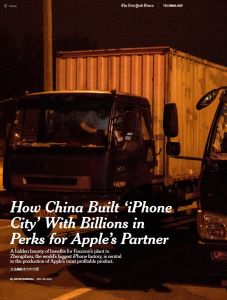Join getAbstract to access the summary!

Join getAbstract to access the summary!
David Barboza
How China Built ‘iPhone City’ with Billions in Perks for Apple’s Partner
A hidden bounty of benefits for Foxconn’s plant in Zhengzhou, the world’s biggest iPhone factory, is central to the production of Apple’s most profitable product.
The New York Times, 2017
What's inside?
The Zhengzhou government is subsidizing the production of your iPhone.
Recommendation
Subsidizing companies that manufacture goods for Western multinationals has been a crucial component of China’s economic policy. A major beneficiary of this policy has been Apple and its manufacturer Foxconn, which operates a large iPhone production facility in Zhengzhou, China. The New York Times correspondent David Barboza has obtained confidential government records and conducted more than 100 interviews to conclude that billions of dollars’ worth of subsidies are behind “iPhone City,” Foxconn’s highly profitable manufacturing site in Zhengzhou. getAbstract recommends Barboza’s investigative report to business leaders with a stake in the Chinese market.
Summary
About the Author
The New York Times correspondent David Barboza has written extensively about US firms doing business in China.


















Comment on this summary